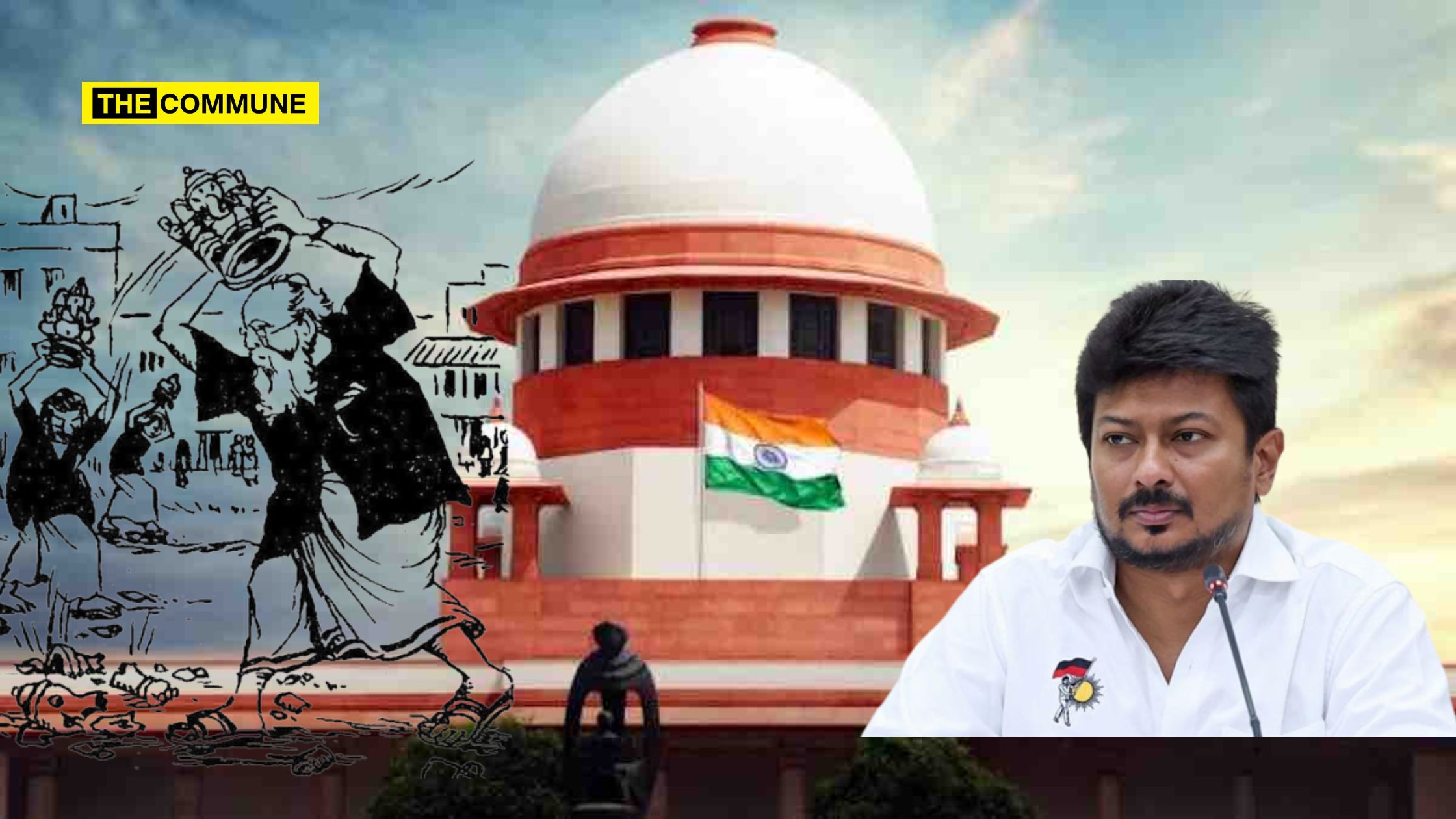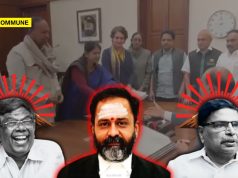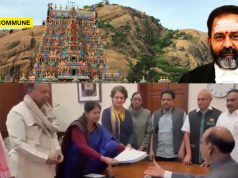
There is a well-known cartoon of EV Ramasamy Naicker (EVR hailed as ‘Periyar’ by his followers) breaking idols of Vinayagar. It based on the real life of incident when EVR smashed an idol of Hindu God Vinayagar in public at the Town Hall maidan in Tiruchirappalli. A Saivite Hindu named S. Veerabadran Chettiar filed a case against EVR under Section 295 and Section 295-A.
According to court records, on 27 May 27 1953, at about 5-30 PM, EVR broke an idol of Vinayagar in public at the Town Hall Maidan, and before breaking the idol, he blatantly stated that his action was intended to insult the feelings of the Hindu community.
The matter first came up to the local court which ordered the police to investigate. The police after investigation said that incident had happened and it was upto the courts to decide whether it was an offense under section 295.
“The mud figure of Ganesa alleged to have been broken by accused is not an object held sacred or worshipped by any class of persons. Simply because it resembled the God Ganesa held in veneration by a section it cannot become an object hold sacred. Even Ganesa idol abandoned by the people as unworthy of worship loses its sanctity and it is no longer an object held sacred by anybody, since such given up idols are found in several places of defilement. It is not an offence if a person treads union any such abandoned idol. Therefore the breaking of mud figure of Ganesa does not amount to an offence under Section 295, Indian Penal Code.“, the lower court magistrate ordered.
The court further added “The speeches delivered by the accused with deliberate and malicious intention of outraging religious feelings of a community, no doubt amount to an offence under Section 295-A, Indian Penal Code. But for laying a complaint under this section the sanction of the Government is necessary. This section has been clearly mentioned in the complaint and it cannot be said it was included by oversight. Without a proper sanction an offence under this section is unsustainable. I therefore see no sufficient ground for proceeding with the complaint and I dismiss the same under section 203, Criminal Procedure Code.”
In effect, the lower court rejected the petitioners arguments stating that a mud representation of a deity did not meet the criteria of being an “object revered by a group of individuals,” as stipulated by IPC section 295.
Subsequently, Veerabadran Chettiar moved the Sessions Court in Trichy for setting aside the lower court’s order. However, the Sessions Court too dismissed Veerabadran Chettiar’s petition saying that it did not amount to an offence.
“I agree with the learned Magistrate that the acts complained of do not amount to an offence. The accused, who profess to be religious reformers in a campaign against idolatory organized a public meeting at which they broke an earthern image of the God Ganesa. The particular image broken was the private property of the accused and was not in itself an object held sacred by any class of persons; nor
do I think that idol breaking by a non-believer can reasonably be regarded by a believer as an insult to his religion; and the ingredients of Section 295, Indian Penal Code, are therefore not made out.“, the Sessions Court in Trichy ruled.
The matter then went to the High Court, which citing a few case laws said that this was not an offence under Section 295 and did not allow further appeal.
“The dolls in the shop, though they may resemble several of the deities in the temple, cannot be held to be objects held sacred by any class of persons. In modern society there are several images of the deities in the drawing rooms of several houses. It cannot for a moment be suggested that these images are objects held sacred. These have got to be distinguished from the objects held sacred, which can only be when they are duly installed in a temple and from which they are subsequently taken out in procession on festival occasions. What was broken therefore by the respondents is nothing more than a doll taken either from a shop or made for the occasion, and it cannot by any means be called ail object held sacred. The offence is not made out and the dismissal is therefore justified.“, the High Court had ruled.
However, under the rights guaranteed by the constitution, the petitioners approached the Supreme Court which was very critical of the lower court judgments and opined in the future such narrow interpretation should not be used and those in charge of law and order were supposed to apply the law based on this judgment.
The judgement delivered by Justice BP Sinha said that the legislative intent behind this provision was to enhance protection for the religious sentiments of communities.
“Any object however trivial or destitute of real value in itself, if regarded as sacred by any class of persons would come within the meaning of the penal section. Nor is it absolutely necessary that the object, in order to be held sacred, should have been actually worshipped. An object may be held sacred by a class of persons without being worshipped by them. It is clear, therefore, that the courts below were rather cynical in so lightly brushing aside the religious susceptibilities of that class of persons to which the complainant claims to belong.“, the Supreme Court said.
The Supreme Court ruled that the lower courts had erred in their preliminary determination that the mud idol did not qualify as an “object held sacred by a class of persons.” The Court even suggested that Lord Ganesha was revered by certain segments of the Hindu community, even if the mud idol had not been formally consecrated.
Furthermore, the Court extended the interpretation of this section to include objects that may not necessarily be objects of worship. The Court emphasized the need for the judiciary to show great respect for people’s religious sentiments and refrain from passing judgment on those beliefs, even when they differ from the Court’s own views or appear irrational.
However, considering the protracted duration of the case, which had spanned over five years, the Court deemed the matter “stale” and declined to order further investigation.
Fast forward to 2023, Tamil Nadu Chief Minister MK Stalin’s son and DMK Minister Udhayanidhi Stalin had equated Sanatana Dharma (Hinduism) to dengue, malaria, corona and called for its eradication. There has been massive outrage from across sections cutting across political parties condemning the DMK Minister’s statement. Former judges, government officials, and war veterans have collectively written a letter to the Chief Justice of India, urging him to initiate suo motu proceedings in response to the hate speech delivered by DMK Minister Udhayanidhi Stalin who had equated ‘Sanatan Dharma’ to diseases and mosquitoes and called for its eradication. Infact, the Supreme Court had in Shaheen Abdulla Vs Union of India case, directed the governments and police authorities to take suo motu action in such cases without waiting for the lodging of formal complaints.
However, the bench led by Chief Justice of India DY Chandrachud in the Supreme Court declined to urgently hear a Public Interest Litigation (PIL) on Udhayanidhi Stalin’s “eradicate Sanatana Dharma” remarks.
The Chief Justice of India declined to entertain the plea filed by a lawyer from the Madras High Court, citing that it had not been listed for urgent consideration and that the Standard Operating Procedure laid out by the court needed to be followed.
It is crystal clear that DMK Minister Udhayanidhi Stalin’s speech reeks of hate and targeted towards a particular community. Will Mi Lords take a look at the Hon’ble Court’s own words to atleast condemn the incendiary hate speech of a person holding public office?
Vallavaraayan is a political commentator fighting Dravidian Stockists.
Click here to subscribe to The Commune on Telegram and get the best stories of the day delivered to you personally.




